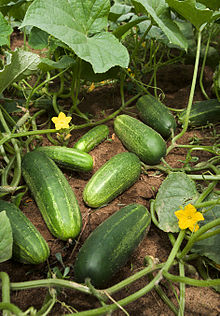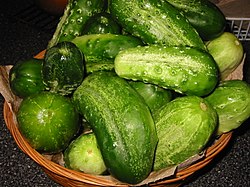Cucumber
From Wikipedia, the free encyclopedia
This article is about the fruit. For other uses, see Cucumber (disambiguation).
| | To comply with Wikipedia's guidelines, the introduction of this article may need to be rewritten. Please discuss this issue on the talk page and read the layout guide to make sure the section will be inclusive of all essential details. (December 2010) |
| Cucumber | |
|---|---|
 | |
| Cucumbers grow on vines | |
| Scientific classification | |
| Kingdom: | Plantae |
| (unranked): | Angiosperms |
| (unranked): | Eudicots |
| (unranked): | Rosids |
| Order: | Cucurbitales |
| Family: | Cucurbitaceae |
| Genus: | Cucumis |
| Species: | C. sativus |
| Binomial name | |
| Cucumis sativus L. | |
| Nutritional value per 100 g (3.5 oz) | |
|---|---|
| Energy | 65 kJ (16 kcal) |
| Carbohydrates | 3.63 g |
| Sugars | 1.67 g |
| Dietary fiber | 0.5 g |
| Fat | 0.11 g |
| Protein | 0.65 g |
| Thiamine (Vit. B1) | 0.027 mg (2%) |
| Riboflavin (Vit. B2) | 0.033 mg (2%) |
| Niacin (Vit. B3) | 0.098 mg (1%) |
| Pantothenic acid (B5) | 0.259 mg (5%) |
| Vitamin B6 | 0.040 mg (3%) |
| Folate (Vit. B9) | 7 μg (2%) |
| Vitamin C | 2.8 mg (5%) |
| Calcium | 16 mg (2%) |
| Iron | 0.28 mg (2%) |
| Magnesium | 13 mg (4%) |
| Phosphorus | 24 mg (3%) |
| Potassium | 147 mg (3%) |
| Zinc | 0.20 mg (2%) |
| Percentages are relative to US recommendations for adults. Source: USDA Nutrient database | |
Contents[hide] |
Botany
The cucumber is a creeping vine that roots in the ground and grows up trellises or other supporting frames, wrapping around ribbing with thin, spiraling tendrils. The plant has large leaves that form a canopy over the fruit.The cucumber is roughly cylindrical, elongated with tapered ends, and may be as large as 60 cm long and 10 cm in diameter. Cucumbers are grown to be eaten fresh (called slicers). Those intended for pickling (called picklers) have a similar appearance. Cucumbers are mainly eaten in the unripe green form. The ripe yellow form normally becomes too bitter and sour. Cucumbers are usually more than 90% water.
Having an enclosed seed and developing from a flower, botanically speaking, cucumbers are classified as fruits. However, much like tomatoes and squash they are usually perceived, prepared and eaten as vegetables.[1]
Flowering and pollination
A few varieties of cucumber are parthenocarpic, the blossoms creating seedless fruit without pollination. Pollination for these varieties degrades the quality. In the US, these are usually grown in greenhouses, where bees are excluded. In Europe, they are grown outdoors in some regions, and bees are excluded from these areas. Most cucumber varieties, however, are seeded and require pollination. Thousands of hives of honey bees are annually carried to cucumber fields just before bloom for this purpose. Cucumbers may also be pollinated by bumblebees and several other bee species.Symptoms of inadequate pollination include fruit abortion and misshapen fruit. Partially pollinated flowers may develop fruit which are green and develop normally near the stem end, but pale yellow and withered at the blossom end.
Traditional varieties produce male blossoms first, then female, in about equivalent numbers. New gynoecious hybrid cultivars produce almost all female blossoms. However, since these varieties do not provide pollen, they must have interplanted a pollenizer variety and the number of beehives per unit area is increased. Insecticide applications for insect pests must be done very carefully to avoid killing off the insect pollinators.
Cucumber genome
In 2009, an international team of researchers announced they had sequenced the cucumber genome (Chinese long' 9930).[2]Taste
| |
Various practices have arisen with regard to how bitterness may be removed from cucumbers. Among these a very common practice popular in India includes slicing off the ends of a cucumber, sprinkling some salt, and rubbing the now-exposed ends of said cucumber with the sliced-off ends until it appears to froth. Another such urban legend states that one ought to peel a cucumber away from the end that was once attached to a vine, otherwise one risked spreading the bitterness throughout the cucumber.[3]
Pickling
Main article: Pickled cucumber
Cucumbers can be pickled for flavor and longer shelf-life. As compared to eating cucumbers, pickling cucumbers tend to be shorter, thicker, less regularly-shaped, and have bumpy skin with tiny white- or black-dotted spines. They are never waxed. Color can vary from creamy yellow to pale or dark green. Pickling cucumbers are sometimes sold fresh as “Kirby” or “Liberty” cucumbers. The pickling process removes or degrades much of the nutrient content, especially that of vitamin C. Pickled cucumbers are soaked in brine or a combination of vinegar and brine, although not vinegar alone, often along with various spices. Pickled cucumbers are often referred to simply as "pickles" in the U.S. or "Gherkins" or "Wallies" in the U.K, the latter name being more common in the north of England where it refers to the large vinegar-pickled cucumbers commonly sold in fish & chip shops. (Although the gherkin is of the same species as the cucumber it is of a completely different cultivar.) - English cucumbers can grow as long as 2 feet (0.61 m). They are nearly seedless, have a delicate skin which is pleasant to eat, and are sometimes marketed as “Burpless”, because the seeds and skin of other varieties of cucumbers are said to give some people gas[citation needed]. Most commonly grown in greenhouses, these parthenocarpic cucumbers are often found in grocery markets shrink-wrapped in plastic.
- East Asian cucumbers are mild, slender, deep green, and have a bumpy, ridged skin. They can be used for slicing, salads, pickling, etc., and are available year-round. They are usually burpless as well.
- Lebanese cucumbers are small, smooth-skinned and mild. Like the English cucumber, Lebanese cucumbers are nearly seedless.
- 'Armenian cucumbers' (also known as yard long) has very long ribbed fruit with a thin skin that does not require peeling, but are actually an immature melon. This is the variety sold in middle-eastern markets as "pickled wild cucumber".[4] In North America, the term “wild cucumber” refers to manroot.
- Persian Cucumber, better known as Mini seedless cucumbers, available from Canada during the summer, and all year-round from the Dominican. Increasing its popularity 30 to 40% a year. Easy to cut on average 5-8 in. long. Vines are parthenocarpic, requiring no pollinators for fruit set.
- Beit Alpha cucumbers are small, sweet parthenocarpic cucumbers adapted to the dry climate of the Middle East
- Apple cucumbers are a short, round cucumber grown in New Zealand and parts of Europe, known for their light yellow-green colour and mildly sweet flavor. When mature, the fruit may grow tiny spines, and contains numerous edible green seeds. The fruit is usually eaten raw, with skin.[5]
- Pickling cucumbers - Although any cucumber can be pickled, commercial pickles are made from cucumbers specially bred for uniformity of length-to-diameter ratio and lack of voids in the flesh.
- Slicers grown commercially for the North American market are generally longer, smoother, more uniform in color, and have a much tougher skin. Slicers in other countries are smaller and have a thinner, more delicate skin.
- Dosakai is a yellow cucumber available in parts of India. These fruits are generally spherical in shape. It is commonly cooked as curry, added in Sambar/Soup, Daal and also in making Dosa-Aavakaaya (Indian Pickle) and Chutney.
- Kekiri is a smooth skinned cucumber relatively hard and not used for salads. It is cooked as spicy curry. It is found in dry zone of Sri Lanka. It becomes orange colored when the fruit is matured.




No comments:
Post a Comment